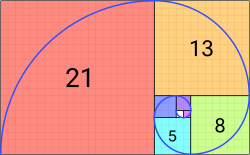Fibonacci number

The Fibonacci numbers are a sequence of numbers in mathematics named after Leonardo of Pisa, known as Fibonacci. Fibonacci wrote a book in 1202, called Liber Abaci ("Book of Calculation"), which introduced the number pattern to Western European mathematics, although mathematicians in India already knew about it.[1][2]
The first number of the pattern is 0, the second number is 1, and each number after that is equal to adding the two numbers right before it together. For example 0+1=1 and 3+5=8. This sequence goes on forever.
F0 F1 F2 F3 F4 F5 F6 F7 F8 F9 F10 F11 F12 F13 F14 F15 F16 F17 F18 F19 F20 0 1 1 2 3 5 8 13 21 34 55 89 144 233 377 610 987 1597 2584 4181 6765
This can be written as a recurrence relation,
- [math]\displaystyle{ F_{n} = F_{n-1} + F_{n-2} }[/math]
For this to make sense, at least two starting points need to be given. Here, [math]\displaystyle{ F_{0} = 0 }[/math] and [math]\displaystyle{ F_1 = 1 }[/math].
Fibonacci numbers in nature

Fibonacci numbers are related to the golden ratio, which shows up in many places in buildings and in nature.[3] Some examples are the pattern of leaves on a stem, the parts of a pineapple,[4] the flowering of artichoke, the uncurling of a fern and the arrangement of a pine cone.[5] The Fibonacci numbers are also found in the family tree of honeybees.[6][7]
Binet's Formula
The nth Fibonacci number can be written in terms of the golden ratio. This avoids having to use recursion to calculate Fibonacci numbers, which can take a computer a long time to do.
- [math]\displaystyle{ F_n = \frac{\varphi^n - (1-\varphi)^n}{\sqrt{5}} }[/math]
Where [math]\displaystyle{ \varphi = \frac{1+\sqrt{5}}{2} }[/math], the golden ratio.
Fibonacci Number Media
A tiling with squares whose side lengths are successive Fibonacci numbers: 1, 1, 2, 3, 5, 8, 13 and 21
The Fibonacci spiral: an approximation of the golden spiral created by drawing circular arcs connecting the opposite corners of squares in the Fibonacci tiling (see preceding image)
A page of Fibonacci's Liber Abaci from the Biblioteca Nazionale di Firenze showing (in box on right) 13 entries of the Fibonacci sequence: the indices from present to XII (months) as Latin ordinals and Roman numerals and the numbers (of rabbit pairs) as Hindu-Arabic numerals starting with 1, 2, 3, 5 and ending with 377.
Solution to Fibonacci rabbit problem: In a growing idealized population, the number of rabbit pairs form the Fibonacci sequence. At the end of the nth month, the number of pairs is equal to Fn.
The Fibonacci numbers are the sums of the diagonals (shown in red) of a left-justified Pascal's triangle.
Fibonacci tree of height 6. Balance factors green; heights red.The keys in the left spine are Fibonacci numbers.
References
- ↑ Parmanand Singh. "Acharya Hemachandra and the (so called) Fibonacci Numbers". Math. Ed. Siwan, 20(1):28-30, 1986. ISSN 0047-6269
- ↑ Parmanand Singh,"The So-called Fibonacci numbers in ancient and medieval India." Historia Mathematica 12(3), 229–44, 1985.
- ↑ S. Douady and Y. Couder (1996). "Phyllotaxis as a Dynamical Self Organizing Process" (PDF). Journal of Theoretical Biology. 178 (3): 255–274. doi:10.1006/jtbi.1996.0026. Archived from the original (PDF) on 2006-05-26. Retrieved 2008-08-01.
- ↑ Jones, Judy; William Wilson (2006). "Science". An Incomplete Education. Ballantine Books. p. 544. ISBN 978-0-7394-7582-9.
- ↑ A. Brousseau (1969). "Fibonacci Statistics in Conifers". Fibonacci Quarterly (7): 525–532.
- ↑ "Computer Science for Fun - cs4fn: Marks for the da Vinci Code: B-". www.cs4fn.org.
- ↑ Scott, T.C.; Marketos, P. (March 2014), On the Origin of the Fibonacci Sequence (PDF), MacTutor History of Mathematics archive, University of St Andrews








